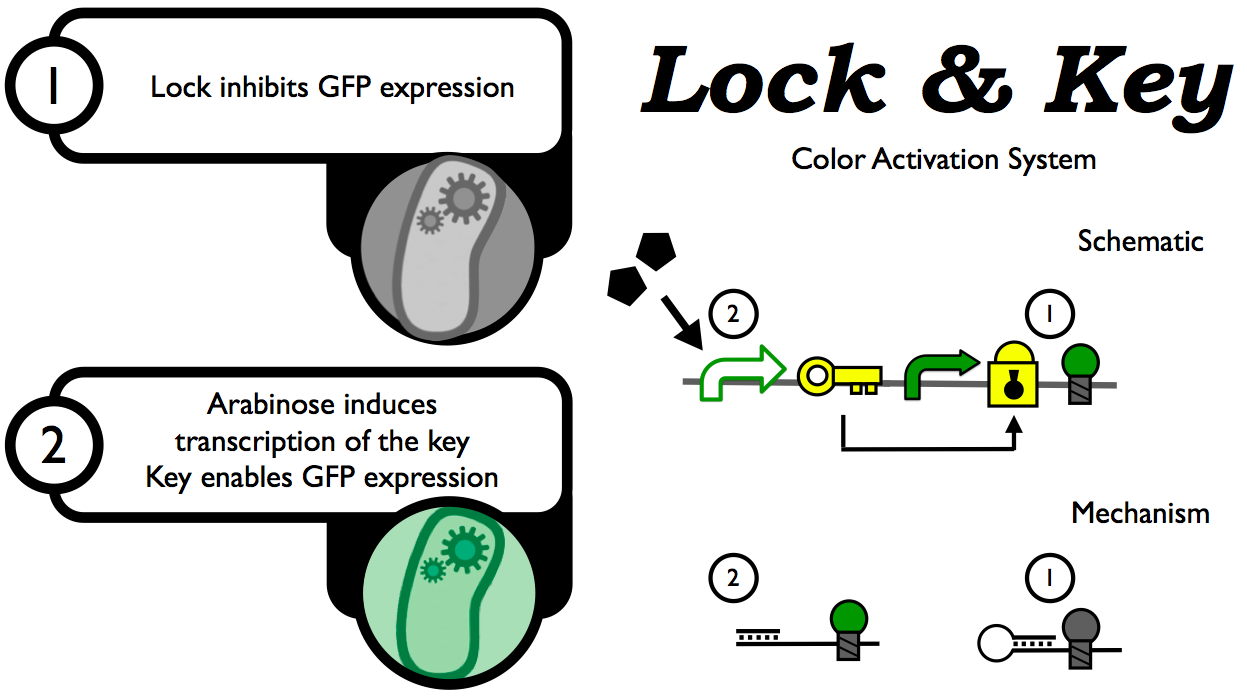Team:British Columbia/LockandKey
From 2009.igem.org
Home Team Traffic Light Sensor Lock&Key Jammer [http://partsregistry.org/cgi/partsdb/pgroup.cgi?pgroup=iGEM2009&group=British_Columbia Parts] Safety Sponsors Notebook Bibliography
Contents |
Lock and Key Subproject
Research Problem
Description of Biological Phenomenon and General Aims of Project
In 2004, Isaacs et al. described a system for regulating gene expression at the RNA level. By inserting an upstream "lock" sequence complementary to the RBS, the RBS becomes unavailable for translation by ribosomes, preventing expression of the target gene. A separately transcribed mRNA, the "key", can interact with a loop region in the locked transcript and preferentially bind the lock sequence, returning the gene to basal expression levels.
Our intention was to adapt this lock and key system to the BioBrick standard, turning it into a modular part that can be used to restrict or allow the transcription of any other part. This would allow us to introduce Boolean logic to our system.
Objectives and Methods
Phase I: Creating the Lock and Key as Biobrick parts
Our initial goal was to create a version of Isaacs et al.'s lock and key that was compatible with the BioBrick standard; the main requirements were to add the BioBrick standard prefix and suffix, and remove internal cut sites shared by assembly restriction enzymes (EXSP), while maintaining the locking/unlocking capacity of the various parts. To begin with, we used the lock (aka cr12), key (aka ta12), and control lock (a sequence of similar length to the lock, but comprising random bases that should not have any binding affinity to the RBS) sequences reported in Isaac et al.'s paper.
Methods:
- Modification of the sequence described in the Isaacs et al. paper in order to prevent unwanted binding of BioBrick "scars"
- Adaptation of the lock, control lock, and key to the BioBrick standard
- Construct the biobrick plasmid by:
- synthesis of oligos from IDT
- second-strand synthesis via PCR
- digestion of prefix/suffix
- ligation into construction plasmid
Phase II: Validating Lock and Key function
First we attempted to demonstrate that the lock functioned as expected, i.e. its presence upstream of a reporter gene prevented the gene from being expressed.
Methods:
- Assembly of lock, control lock, and control RBS with a constitutive promoter and several different reporter genes
- Qualitative evaluation by observing fluorescent reporter and lacZ expression
- Quantitative evaluation by performing a beta-galactosidase timecourse
Results
Phase I:
Using an RNA secondary structure prediction program, we found that the Biobrick scars were complementary to each other, raising the possibility that they would prevent the key from unlocking the lock. The 5' and 3' flanking sequences of the lock were shortened by 6 nucleotides and the sequence was altered, respectively, to mitigate this problem (see figure 1). One nucleotide was altered so as to keep the number of bulges at three.

Figure 1. Proposed modifications to the lock from Isaacs et al. to render it compatible with the BioBrick standard.
Isaacs’: GAATTCTACCATTCACCTCTTGGATTTGGGTATTAAAGAGGAGAAAGGUACC UBC iGEM:TACTAGAGAAGCGCAGTAATTCACCTCTTGGATTTGGGTATCAAAGAGGAGAAATACTAG
Figure 2: Sequence alignment of lock sequence pre- and post-modification, with changes highlighted.
Sequence verified insertion of lock, control lock, and key into a construction plasmid
Phase II:
After assembling the lock, control lock, and a control RBS (B0034) with our strongest constitutive promoter (J23100) and various reporter genes, we observed:
- no naked-eye-visible fluorescence from either lock or control lock assembled with RFP, YFP, or GFP_LVA (vs. visible fluorescence from the control RBS with all of these genes)
- blue colonies on IPTG and X-gal from both the lock and the control lock assembled with lacZ
Hypothesizing that the lock might exhibit a delayed rate of lacZ gene expression, even if it reached the same eventual maximum as the control, a timecourse was performed to measure lacZ expression by quantifying beta-galactosidase activity on a colorigenic substrate. However, no significant difference was observed between the lock and control over 16 hours of induction (see figure 3).

Figure 3. Beta-galactosidase activity of lock and control cultures over time. Each point represents the mean of 3 biological replicates (which are in turn the mean of two experimental replicates). Miller Units represent A420 absorbance normalized to OD600.
Proposed Future Experiments
With the results thus far, there is no conclusive evidence to suggest that the lock as designed is performing its expected role, i.e. repressing gene expression. It is within the realm of possibility that the modifications necessary for adapting the lock to a Biobrick have also abrogated the lock's activity. Isaacs et al. also noted the difficulty in changing a part of the lock and were unable to improve the lock's efficacy via rational design.
If future work would be done on this part to make it work, the following procedures could be performed to discover the feasibility of converting the lock into the Biobrick standard:
1. Mutagenize the lock back into the Isaacs original form,
- Rationale: We believe that our modifications are what made the lock stop working, we will hope that the complementarity of the scars has a negligible effect on activity
2. Mutagenize the lock with randomized primers, screen using lacZ to find working locks
- Rationale: We believe that our modifications have made the lock stop working, introducing random mutations will produce a higher chance of finding a working lock
 "
"
